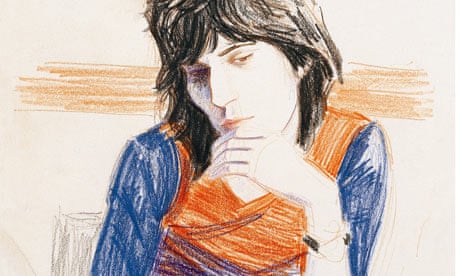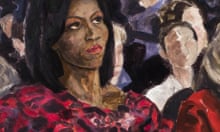There is a naive innocence to the portraits of superstars by Elizabeth Peyton, as if they've been painted by a schoolgirl with a crush. Copying from photographs in the pages of Rolling Stone magazine and Hello!, Peyton instils romance and mysticism into the quixotic figures of Peter Doherty and Kurt Cobain. Each picture is painted in oil or watercolour, with the drips running down the page as if the figures might melt into the background. For a time, most of her portraits were of men, all imbued with a cool, androgynous quality. It would be easy to dismiss them as the work of a fame-fixated teenager, but these are not random passions. Peyton chooses her subjects carefully, selecting people for whom she feels a close affinity and manipulating glossy press photographs into intimate, painted portraits. What is surprising is their size, often no more than 11in high; these larger-than-life characters are brought down from their pedestals into the confines of Peyton's tiny canvasses.
Born in Danbury, Connecticut in 1965, Peyton began drawing people at a young age. Surprisingly, her early subjects were not the local bands but Napoleon and the British royal family. Her first exhibition, organised by Gavin Brown in 1993 at the Chelsea Hotel, didn't feature that establishment's notorious ex-inhabitants – people such as Sid Vicious and Patti Smith, whom she would later come to paint – but pictures of 18th- and 19th-century literary and political heroes.
The first contemporary portrait Peyton tackled was that of Kurt Cobain, in her belief that the cult of the celebrity was the subject of her time. It is something she is often forced to defend, and like Andy Warhol, she is very aware of the insatiable fascination for her subject matter. In interviews, she seems to imply it is not the beauty or the talent of famous people that mesmerises her, but their rebellious dismissal of societal constraints. Her subjects are those musicians – the Jarvis Cockers, the Kurt Cobains, the Keith Richardses – who, arguably, remain true to themselves: personalities uninhibited by management, record contracts and the like. This untouchable quality remains a constant in her work, whether she is painting political leaders, artists, actors or her boyfriends. The common theme is that each, in some form or another, inspires her devotion.
The price of fame: The paradox for Peyton is her portraits command such a high price – an early painting of John Lennon recently fetched $800,000 (£545,000) – that they have become almost as far out of reach for most people as the celebrities themselves.
Strange but true: She was once married to the artist Rirkrit Tiravanija, who transformed the Serpentine Gallery into a replica of his New York apartment.



